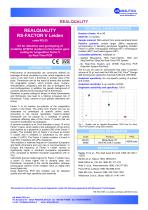 Website:
AB Analitica
Website:
AB Analitica
Catalog excerpts

pANALITICA ADVANCED BIOMEDICINE www.abanalitica.it REALQUALITY REALQUALITY RS-FACTOR V Leiden code RQ-25 Kit for detection and genotyping of mutation G1691A (Leiden) in the human gene coding for coagulation factor V by Real-Time PCR Phenomena of thrombophilia are commonly defined as blockage of blood circulation by clots, which originate in the veins or are stem from a thrombus in another area of the body. Thrombosis can be the result of events that activate the coagulation system, which include injury, surgery, immobilization, pregnancy and the use of estrogens and oral contraceptives. In addition, the genetic background of a person influences the individual risk of thrombosis. Mutations in genes coding for factors of blood homeostasis and fibrinolysis may lead to a lifelong increased risk of thrombosis. Today, several of such genetic alterations are known. Factor V is an inactive pro-cofactor of the coagulation system in the blood. The active form (Factor Va) can be inactivated by proteolysis at specific amino acids. According to the current hypothesis, Factor-V-related thrombosis can be caused by a multitude of genetic mutations affecting sites of the Factor V protein that are crucial for inactivation by proteolysis. A common mutation is an G!A transition in exon 10 of the Factor V gene, which leads to the substitution of the amino acid arginine by a glutamine in position 506 of the Factor V protein. This mutated form of Factor V is known as Factor V Leiden and is resistant to inactivation by the active protein C (APC). The Factor V Leiden mutation is found in over 90% of patients with APC-resistance. This mutation is relatively frequent in Caucasian Europeans and North Americans and very rare in non-Caucasians. In Europe, the frequency of Factor V Leiden carriers is significantly higher in Southern Europeans populations (7%) compared to Northern European populations (2% to 3%). Individuals that are heterozygous for Factor V Leiden have a seven (7) times higher risk to develop deep vein thrombosis, compared to the normal population, whereas homozygous carriers of the mutation have an eighty (80) times higher risk. Using Real-Time PCR this mutation can be detected quickly and with high specificity and sensitivity. Number of tests: 48 or 96 Shelf life: 12 months Sample material: DNA extract from whole peripheral blood Positive controls: contain target (DNA) sequences corresponding to following genotypes regarding mutation Factor V Leiden: homozygous wild-type (WT), homozygous mutated (MUT) and heterozygous (HET) Compatible platforms: Validated on ■ Applied Biosystems 7500 Fast / Fast Dx, 7300 and StepOnePlus / StepOne Real-Time PCR System ■ Dx Real-Time System and CFX96 Real-Time PCR Detection System (Bio-Rad) The kit can be used on instruments that allow a reaction volume of 25 pL and read the FAM and CAL Fluor® Orange 560 fluorescence (detection channels FAM and JOE/HEX). Analytical specificity: No non-specific pairing of primers and probes Analytical sensitivity: 2 ng / reaction of DNA Diagnostic sensitivity and specificity: 100 % Bagley PJ et al., Proc Natl Acad Sci USA 1998; 95:1321713220. Bertina et al., Nature 1994; 369:64-67. Malik NM et al., Clin Sci 1998; 95: 311-315. Motti C, et al., Atherosclerosis 1998; 139:377-383. Poort SR et al.,Blood 1996; 88:3698-3703. Saiki RK et al., Science 1985; 230:1350-1354. Williamson D et al., Blood 1998; 91:1140-1144.
Open the catalog to page 1All AB Analitica catalogs and technical brochures
-
Catalogue 2023
36 Pages
-
EQA PROGRAMME CATALOGUE
77 Pages
-
AB 13C Breath test
4 Pages
-
PRODUCT CATALOG 2018
16 Pages
-
HP UREASI TEST
2 Pages
-
HPV-TYPE EXPRESS
2 Pages
-
PRODUCT LIST 2017
20 Pages
-
GENEQUALITY DDK-G17
1 Pages
-
Product list 2016
24 Pages












